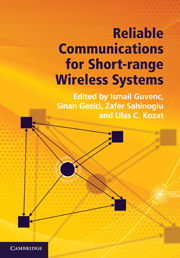Book contents
- Frontmatter
- Contents
- List of contributors
- 1 Short-range wireless communications and reliability
- Part I High-rate systems
- Part II Low-rate systems
- 6 ZigBee networks and low-rate UWB communications
- 7 Impact of channel estimation on reliability
- 8 Interference mitigation and awareness for improved reliability
- 9 Characterization of Wi-Fi interference for dynamic channel allocation in WPANs
- 10 Energy saving in low-rate systems
- Part II Selected topics for improved reliability
- Index
8 - Interference mitigation and awareness for improved reliability
from Part II - Low-rate systems
Published online by Cambridge University Press: 01 June 2011
- Frontmatter
- Contents
- List of contributors
- 1 Short-range wireless communications and reliability
- Part I High-rate systems
- Part II Low-rate systems
- 6 ZigBee networks and low-rate UWB communications
- 7 Impact of channel estimation on reliability
- 8 Interference mitigation and awareness for improved reliability
- 9 Characterization of Wi-Fi interference for dynamic channel allocation in WPANs
- 10 Energy saving in low-rate systems
- Part II Selected topics for improved reliability
- Index
Summary
Wireless systems are commonly affected by interference from various sources. For example, a number of users that operate in the same wireless network can result in multiple-access interference (MAI). In addition, for ultrawideband (UWB) systems, which operate at very low power spectral densities, strong narrowband interference (NBI) can have significant effects on the communications reliability. Therefore, interference mitigation and awareness are crucial in order to realize reliable communications systems. In this chapter, pulse-based UWB systems are considered, and the mitigation of MAI is investigated first. Then, NBI avoidance and cancelation are studied for UWB systems. Finally, interference awareness is discussed for short-rate communications, next-generation wireless networks, and cognitive radios.
Mitigation of multiple-access interference (MAI)
In an impulse radio ultrawideband (IR-UWB) communications system, pulses with very short durations, commonly less than one nanosecond, are transmitted with a low-duty cycle, and information is carried by the positions or the polarities of pulses [1–5]. Each pulse resides in an interval called “frame”, and the positions of pulses within frames are determined according to time-hopping (TH) sequences specific to each user. The low-duty cycle structure together with TH sequences provide a multiple-access capability for IR-UWB systems [6].
Although IR-UWB systems can theoretically accommodate a large number of users in a multiple-access environment [2, 4], advanced signal processing techniques are necessary in practice in order to mitigate the effects of interfering users on the detection of information symbols efficiently [6].
Information
- Type
- Chapter
- Information
- Reliable Communications for Short-Range Wireless Systems , pp. 190 - 233Publisher: Cambridge University PressPrint publication year: 2011
Accessibility standard: Unknown
Why this information is here
This section outlines the accessibility features of this content - including support for screen readers, full keyboard navigation and high-contrast display options. This may not be relevant for you.Accessibility Information
- 1
- Cited by
